Impact of Automation on Enhancing Energy Quality in Grid-Connected Photovoltaic Systems
Abstract
:1. Introduction
2. Materials and Methods
2.1. The Electrical System, General Characteristics
2.2. The Electrical System Analyzer
2.3. The Power System, Statistical Analysis
2.4. Selection of the Elements
2.4.1. Capacitor Bank Selection
2.4.2. Voltage and Current Filter Selection
| THD 1 | Harmonic distortion | Vllsis | Supply voltage | |
| Ik | Rated current | Ifund | Fundamental Current | |
| I1 | Maximum current | R | Resistance | |
| Xc | Capacitive reactance | Itotal | Current Total | |
| h | Fundamental current | Vc(h) | Fundamental Voltage | |
| Xeff | Effective reactance | Vcl ntotal peak | Peak total Voltage | |
| C | Capacitance | Vl.Npeak sis | Voltage Peak System | |
| f | Frequency | Vl. Nsis | Nominal Voltage | |
| L | Inductance | %Current Voltage | Current Voltage | |
| VLL | Base Voltage | |||
| Va.u. | Voltage per unit |
2.4.3. Photovoltaic System Selection
| Ec | Daily energy consumption | Vinv | Inverter voltage |
| Voc | Open circuit voltage | Vm | Panel rated voltage |
| Isc | Short circuit current | Iinv | Inverter current |
| H.S.P. | Peak sun hours | Im | Panel rated current |
3. Results and Discussion
3.1. Simulation 1 of 7: The Automation Scheme Energizing Only the Capacitor Bank
3.2. Simulation 2 of 7: Energizing Only the Voltage and Current Filter
3.3. Simulation 3 of 7: Energizing Only the Photovoltaic System
3.4. Simulation 4 of 7: Energizing the Capacitor Bank Together with the Voltage and Current Filter
3.5. Simulation 5 of 7: Energizing the Capacitor Bank Together with the Photovoltaic System
3.6. Simulation 6 of 7: Energizing the Voltage and Current Filter Together with the Photovoltaic
3.7. Simulation 7 of 7: Energizing the Three Elements: Capacitor Bank, Photovoltaic System, Voltage and Current Filter
4. Conclusions
- When operating only the capacitor bank, the power factor improved to 93.42%. This improvement in the power factor also led to better control over the characteristics of current fluctuations.
- When both control systems operate, the photovoltaic system together with the voltage and current filter improves the power factor to 94.21%, reducing voltage and current fluctuations, resulting in a more stable waveform on bus 4.
- One of the significant contributions of the analysis lies in the interaction of the control scheme. An important improvement, compared to other research contributions, is achieved by energizing the voltage control and current filter systems simultaneously withthe photovoltaic system. This integrated approach leads to notable results, such as a current of 8.7 A and a power factor of 94.21% on the high side of transformer T1 and a current of 259.7 A and a power factor of 94.81% on bus 4. The formation of the final waveform is regular, indicating that this operational scheme is one of the most effective contributions to the system’s control.
- Current variations outside the specified range in the system have a significant impact on the disturbances in the electrical system.
- Constant voltage variations in values can lead to significant disturbances and failures in the system.
- Power factor levels may be below the allowed limits due to insufficient power compensation in the operation of the equipment.
- The integration of photovoltaic systems with inverters introduces harmonics into the electrical system.
- Integrating power quality control elements into the electrical system of an industrial plant is challenging.
- These elements include a capacitor bank, a voltage and current filter and a photovoltaic system to interface with the grid, which results in an extra cost for the company.
- Carrying out the installation and adaptation of the equipment in the electrical system as well as the development of tests is resource intensive.
Author Contributions
Funding
Institutional Review Board Statement
Informed Consent Statement
Data Availability Statement
Conflicts of Interest
Glossary and Abbreviations
| Cos υ | power factor |
| Qc | capacitor bank |
| Xc | capacitive reactance |
| C | capacitor |
| L | inductor |
| Vinv | Inveter voltage |
| Im | current module |
| Vm | voltage module |
| Etap | Model, analysis and optimization of energy system |
| MACEP | Mesh and armex of Aguascalientes S.A. de C.V. |
| CFE | Federal Electricity Commission a public company with a social character that provides electric power in Mexico. |
| GDMTH | High Demand Medium Voltage Hourly |
| IEEE | Institute of Electrical and Electronics Engineers |
| PCC | short-circuit power |
References
- Erazo, O.; Quevedo, P. Power Quality Analysis and redesign of the electrical system at the industrial plant project corporation. Multiple Multi-Projects S.A. Guayaquil Ecuador. Bachelor’s Thesis, Salesian Polytechnic University, Cuenca, Ecuador, 2018. [Google Scholar]
- Alcayde-García, F.; Salmerón-Manzano, E.; Montero, M.A.; Alcayde, A.; Manzano-Agugliaro, F. Power Transmission Lines: Worldwide Research Trends. Energies 2022, 15, 5777. [Google Scholar] [CrossRef]
- Afkar, H.; Esmaeeli, M. Complete load Compensation in a Distribution Network with a Single-Stage PV Grid Interface Converter. J. Energy Eng. Mang. 2023, 12, 18–19. [Google Scholar] [CrossRef]
- Valtierra-Rodriguez, M.; de Jesus Romero-Troncoso, R.; Osornio-Rios, R.A.; Garcia-Perez, A. Detection and Classification of Single and Combined Power Quality Disturbances Using Neural Networks. IEEE Trans. Ind. Electron. 2014, 61, 2473–2482. [Google Scholar] [CrossRef]
- Singh, A.K.; Kumar, S.; Singh, B. Solar PV Energy Generation System Interfaced to Three Phase Grid with Improved Power Quality. IEEE Trans. Ind. Electron. 2020, 67, 3798–3808. [Google Scholar] [CrossRef]
- Amirullah; Penangsang, O.; Soeprijanto, A. Effect of Installation of Photovoltaic (PV) Generation to Power Quality in Industrial and Residential Custumers Distribution Network. In Proceedings of the International Seminar on Intelligent Technology and Its Applications, Its Applications (ISITIA), Surabaya, Indonesia, 20–21 May 2015; pp. 193–200. [Google Scholar] [CrossRef]
- Daza, A.U.; Buriticá, C.I.; Garzón, Y.R. Experimental study of powers, power factor in industrial loads taking as reference the norm IEEE Std 1459-2010. Tecnura 2015, 16, 41–54. [Google Scholar]
- Issouribehere, P.E.; Barbero, J.C.; Barbera, G.A. Comparative Study of the Different Definitions of Voltage and Current Unbalance Factors in Three-Phase Systems. In Proceedings of the CIGRE Ibero-American Regional Meeting, Puerto de Iguazú, Argentina, 24–28 May 2009; Volume 12, pp. 1–8. Available online: http://sedici.unlp.edu.ar/bitstream/handle/10915/36357/Documento_completo.pdf?sequence=1 (accessed on 15 July 2021).
- Silva, M.A.; Ordóñez, G.P. Power Quality: Design and Construction of a Prototype as an Alternative for Monitoring Power Outages and Brownouts. Redalyc. UIS Ing. 2005, 1, 1–14. Available online: https://www.redalyc.org/articulo.oa?id=553756895005 (accessed on 20 May 2020).
- Souza, G.; Santos, R.; Saraiva, E. A Log-Logistic Predictor for Power Generation in Photovoltaic Systems. Energies 2022, 15, 5973. [Google Scholar] [CrossRef]
- Wang, H.; Wang, J.; Piao, Z.; Meng, X.; Sun, C.; Yuan, G.; Zhu, S. The Optimal Allocation and Operation of an Energy Storage System with High Penetration Grid-Connected Photovoltaic Systems. Sustainability 2020, 12, 6154. [Google Scholar] [CrossRef]
- Beltrán, M.E.; Boscán, N. Identification of Needs for the Acquisition of Technology for the Production of Electrical Energy through the Use of Photovoltaic Systems in Venezuela. Redalycle 2011, 10, 89–106. Available online: http://www.redalyc.org/articulo.oa?id=78421854006 (accessed on 28 August 2019).
- Sousa, V.S.; Gómez, J.S. Power Quality and State-of-Load Analysis in a Power Switching and Transformation Station. Int. J. Manag. Sci. Oper. Res. 2019, 4, 27–32. Available online: http://ijmsoridi.com/index.php/ijmsor/article/view/109/98 (accessed on 18 May 2020).
- Arteaga, D.J. Virtual Reality Training System for Monitoring Power Quality Indicators in Electrical Substation. Master’s Thesis, Autonomous University of Queretaro, San Juan del Rio, Mexico, 20 March 2021. Available online: https://ri-ng.uaq.mx/handle/123456789/2797 (accessed on 7 February 2020).
- Carreño Perez, J.C.; Espinel Ortega, A. Identificación de Activos y Ciber Activos Críticos En Sistemas de Transmisión de Energía Eléctrica. Tecnura 2020, 24, 27–38. [Google Scholar] [CrossRef]
- Beltran, T.A.; López, F.E.; Beltran, C.S. Bridge Inverter Power Quality Analysis and SPWM Control. Energy Eng. 2020, 41, 1–11. Available online: https://dialnet.unirioja.es/ejemplar/544727 (accessed on 16 September 2021).
- Marcelo, G.T. Estimated Cost of Electricity with Time Horizon for Micro Grid Based on the Policy Response of Demand for Real Price of Energy. Enfoque Ute 2020, 4, 41–55. Available online: http://ingenieria.ute.edu.ec/enfoqueute (accessed on 11 October 2021).
- De Oliveira, V.; Vilela, D.F.; Vilela, T.F. Study of the Anatomy of Losses in Electric Energy Distribution. Energy Eng. 2022, 43, 1–10. Available online: https://rie.cujae.edu.cu/index.php/RIE/article/view/646/791 (accessed on 2 January 2023).
- Amaya, L.V.; Inga, E. Location of Harmonic Distortions in Electrical Systems using Compressed Sensing. Eng. Compet. 2022, 24, e30511037. Available online: https://www.redalyc.org/journal/2913/291371829032/html/ (accessed on 7 February 2023).
- Martins, J.C.; Morandi, M.I.; Lacerda, D.P.; Andrade, B.P. Energy Efficiency Decision-Making in Non-Energy Intensive Industries: Content and Social Network Analysis. Production 2022, 32, e20210065. [Google Scholar] [CrossRef]
- Angelino dos Santos, T.; Gomes de Freitas, F.; Carvalho Gonçalves, D.L.; Fernández-Ramírez, L.M. Design and Validation of IOT Measurement System for Photovoltaic Generation. Ingenius 2022, 28, 44–52. [Google Scholar] [CrossRef]
- Herrera, R.C.; García, J.G.; Bello, B.; Herrera, F.B. Proposal of an Intelligent Predictive Model for a Photovoltaic Plant. Cuba. J. Comput. Sci. 2022, 16, 144–162. Available online: https://www.redalyc.org/journal/3783/378370413010/movil/ (accessed on 22 March 2023).
- Camargo, F.G. Fuzzy Multi-Objective Optimization of the Energy Transition towards Renewable Energies with a Mixed Methodology. Production 2022, 32, e20210132. [Google Scholar] [CrossRef]
- Thango, B.A.; Bokoro, P.N. Battery Energy Storage for Photovoltaic Application in South Africa: A Review. Energies 2022, 15, 5962. [Google Scholar] [CrossRef]
- Mastromauro, R.A.; Liserre, M.; Kerekes, T.; Dell’Aquila, A. A Single-Phase Voltage-Controlled Grid-Connected Photovoltaic System with Power Quality Conditioner Functionality. IEEE Trans. Ind. Electron. 2009, 56, 4436–4444. [Google Scholar] [CrossRef]
- Tareen, W.U.; Mekhilef, S.; Seyedmahmoudian, M.; Horan, B. Active Power Filter (APF) for Mitigation of Power Quality Issues in Grid Integration of Wind and Photovoltaic Energy Conversion System. Renew. Sustain. Energy Rev. 2017, 70, 635–655. [Google Scholar] [CrossRef]
- Hai, T.; Zhou, J.; Rezvani, A.; Le, B.N.; Oikawa, H. Optimal Energy Management Strategy for a Renewable Based Microgrid with Electric Vehicles and Demand Response Program. Electr. Power Syst. Res. 2023, 221, 109370. [Google Scholar] [CrossRef]
- Marmolejo-Duarte, C.; Chen, A. Uncovering the Price Effect of Energy Performance Certificate Ratings When Controlling for Residential Quality. Renew. Sustain. Energy Rev. 2022, 166, 112662. [Google Scholar] [CrossRef]
- Zhang, W.; Wu, Y.; Calautit, J.K. A Review on Occupancy Prediction through Machine Learning for Enhancing Energy Efficiency, Air Quality and Thermal Comfort in the Built Environment. Renew. Sustain. Energy Rev. 2022, 167, 112704. [Google Scholar] [CrossRef]
- IEEE STD 519-2022; Standard for Harmonic Control in Electric Power Systems. (Revision of IEEE STD 519-2014). IEEE: New York, NY, USA, 2022; pp. 1–15. [CrossRef]
- Gandoman, F.H.; Ahmadi, A.; Sharaf, A.M.; Siano, P.; Pou, J.; Hredzak, B.; Agelidis, V.G. Review of Facts Technologies and Applications for Power Quality in Smart Grids with Renewable Energy Systems. Renew. Sustain. Energy Rev. 2018, 82, 502–514. [Google Scholar] [CrossRef]
- Das, C.K.; Bass, O.; Kothapalli, G.; Mahmoud, T.S.; Habibi, D. Overview of Energy Storage Systems in Distribution Networks: Placement, Sizing, Operation, and Power Quality. Renew. Sustain. Energy Rev. 2018, 91, 1205–1230. [Google Scholar] [CrossRef]
- Rauch, J.; Brückl, O. Achieving Optimal Reactive Power Compensation in Distribution Grids by Using Industrial Compensation Systems. Electricity 2023, 4, 78–95. [Google Scholar] [CrossRef]
- Mulenga, E. Solar PV Stochastic Hosting Capacity Assessment Considering Epistemic (e) Probability Distribution Function (PDF). Electricity 2022, 3, 586–599. [Google Scholar] [CrossRef]
- Ayala, L.C. Energy Quality: Characteristics and Limits of Disturbances of Electric Power Parameters; Technical Manual; CFE (Commission Electricity): Mexico City, Mexico, 2009; Available online: https://lapem.cfe.gob.mx/normas/pdfs/I0000-70.pdf (accessed on 21 October 2019).
- Corporation, F. Fluke 434-II/435-II/435-II/437-II Three-Phase Power and Power Quality Analyzer User’s Manual; Netherlands Test World: Rocklin, CA, USA, 2012; Available online: https://testworld.com/wp-content/uploads/user-manual-fluke-434-435-three-phase-quality-analyzer.pdf (accessed on 8 November 2020).
- Ayaz Atalan, Y.; Tayanç, M.; Erkan, K.; Atalan, A. Development of Nonlinear Optimization Models for Wind Power Plants Using Box-Behnken Design of Experiment: A Case Study for Turkey. Sustainability 2020, 12, 6017. [Google Scholar] [CrossRef]
- Minitab Statistical Software. Available online: https://www.minitab.com/en-us/products/minitab/free-trial/2020 (accessed on 10 June 2021).
- Abdul Kadir, A.F.; Khatib, T.; Elmenreich, W. Integrating Photovoltaic Systems in Power System: Power Quality Impacts and Optimal Planning Challenges. Int. J. Photoenergy 2014, 2014, 321826. [Google Scholar] [CrossRef]
- Chandra, A.; Agarwal, T. Capacitor Bank Designing for Power Factor Improvement. Int. J. Emerg. Technol. Adv. Eng. 2014, 4, 235–239. Available online: https://www.ijetae.com/Volume4Issue8.html (accessed on 5 May 2019).
- ETAP, O.T. Version 21.1.0. 2022. Available online: https://etap.com/es/demo-download (accessed on 22 March 2023).
- Le Nguyen, H. Newton-Raphson Method in Complex form [Power System Load Flow Analysis]. IEEE Trans. Power Syst. 1997, 12, 1355–1359. [Google Scholar] [CrossRef]
- Suarez, J.A.; di Mauro, G.; Anaut, D.; Aguero, C. Analysis of the Harmonic Distortion and the Effects of Attenuation and Diversity in Residential Areas. IEEE Lat. Am. Trans. 2005, 3, 53–59. [Google Scholar] [CrossRef]
- Sánchez, G.; Franco, G. Design and Implementation of a Photovoltaic System Interconnected to the grid with storage support at the Technological University of Pereira, Faculty of Technology, and Degree Thesis of Bechelor. May 2016. Available online: https://repositorio.utp.edu.co/bitstreams/3a02efc9-d8fb-432a-b2ee-e50b181dd11b/download (accessed on 22 October 2020).

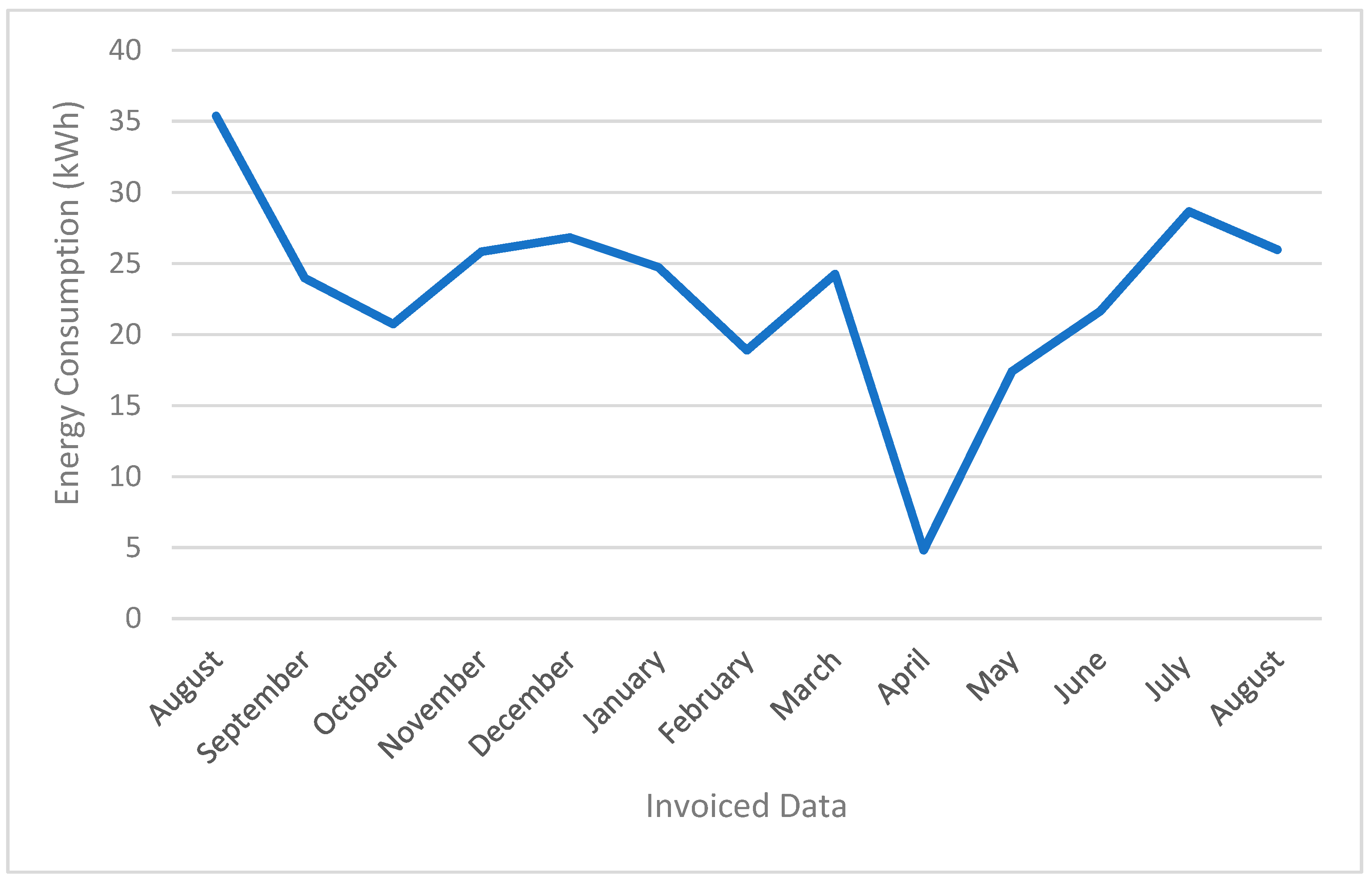
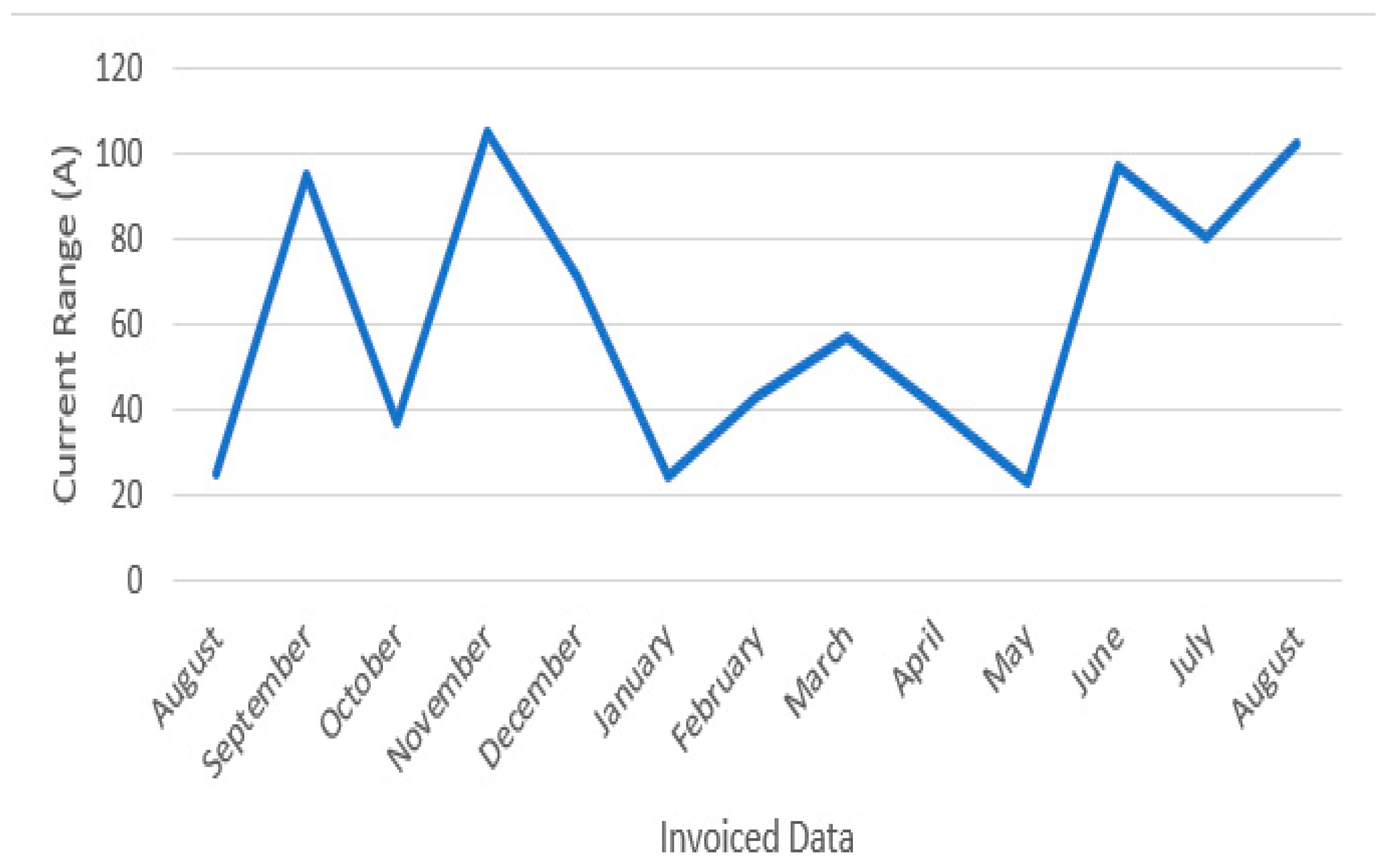
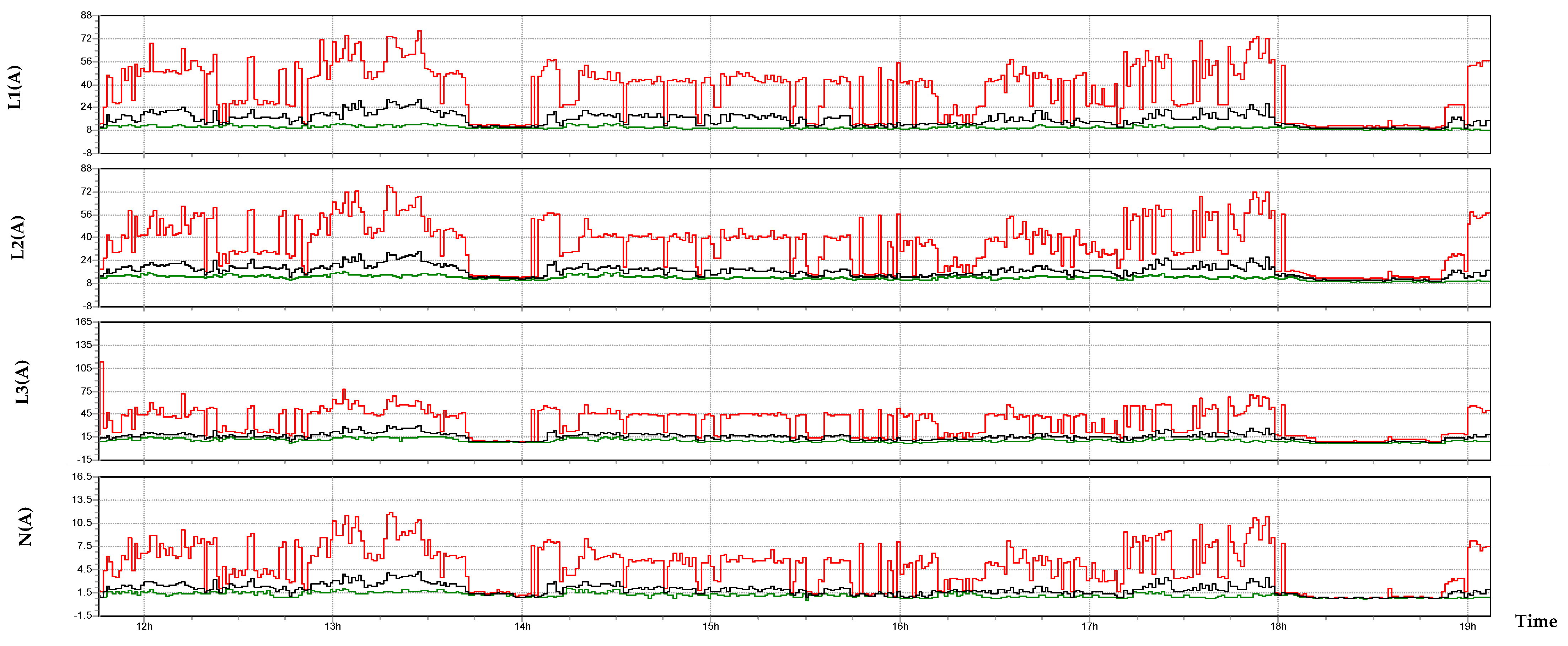
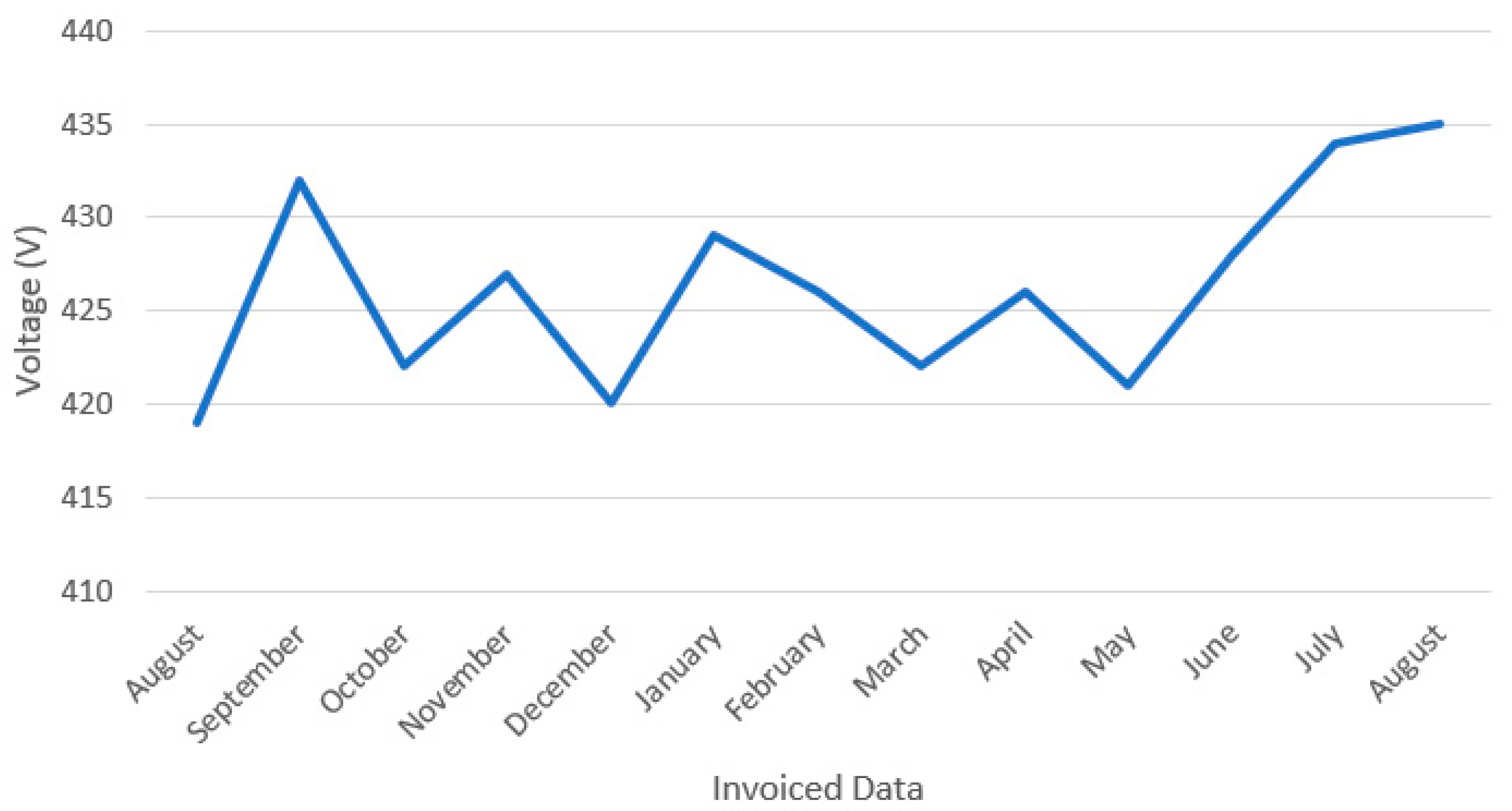
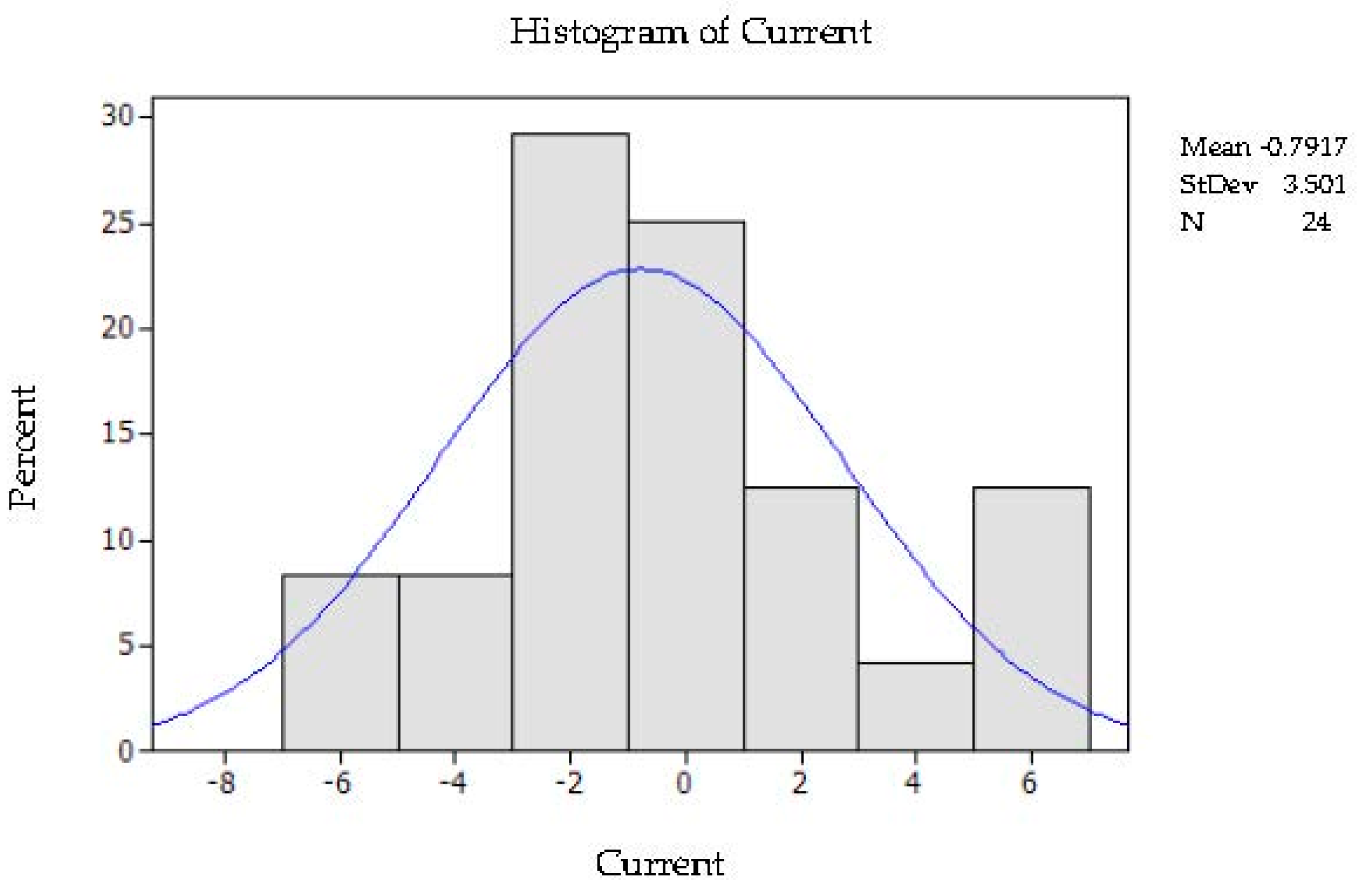


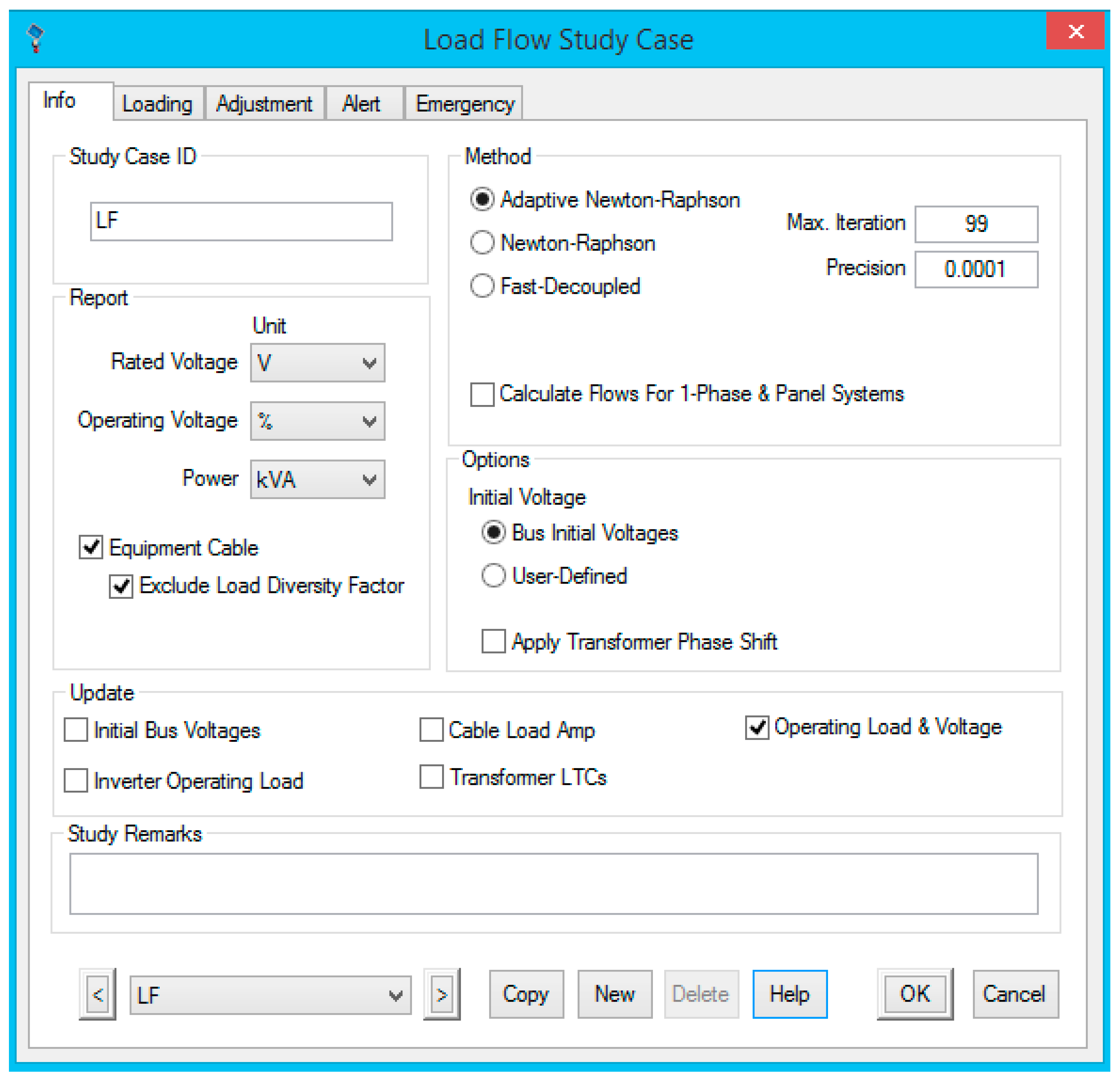
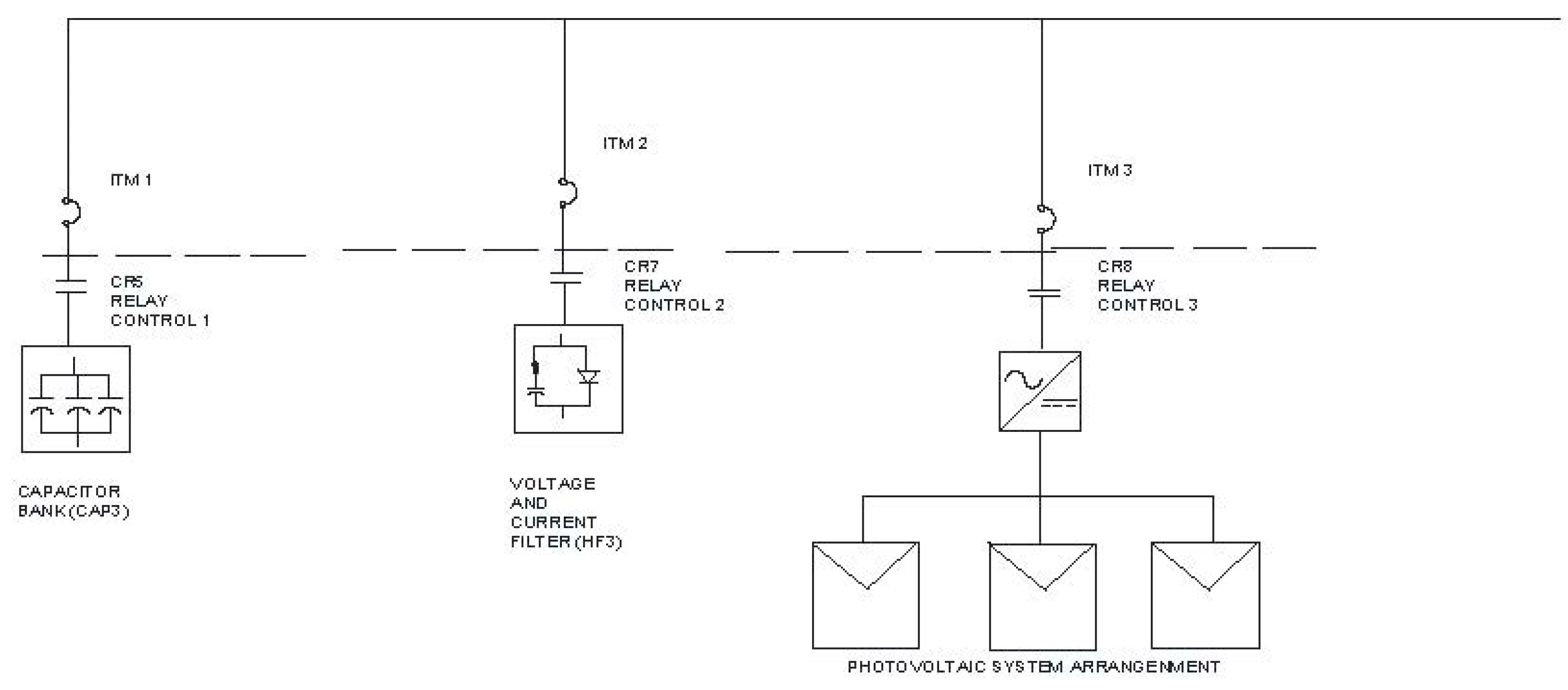
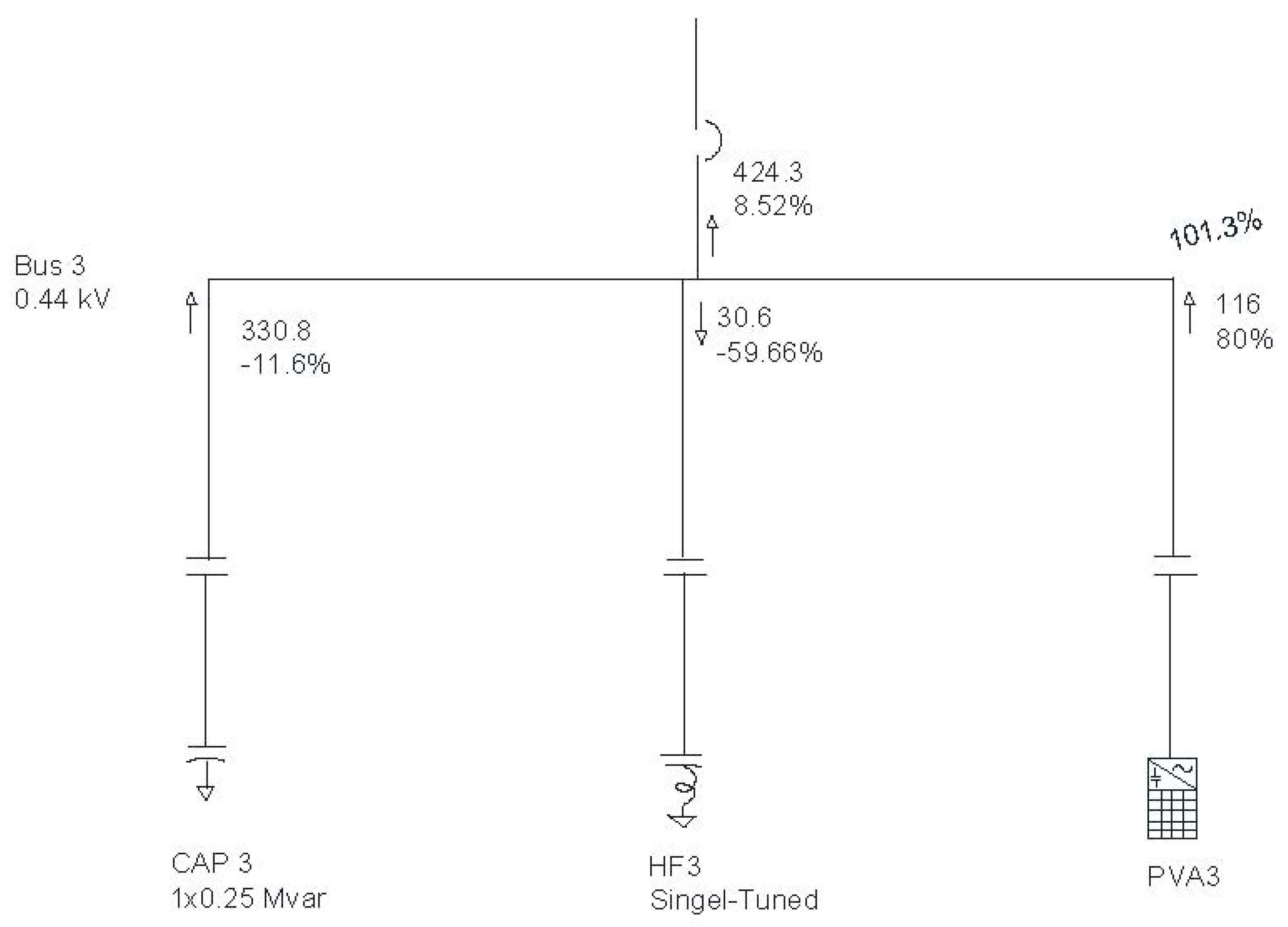
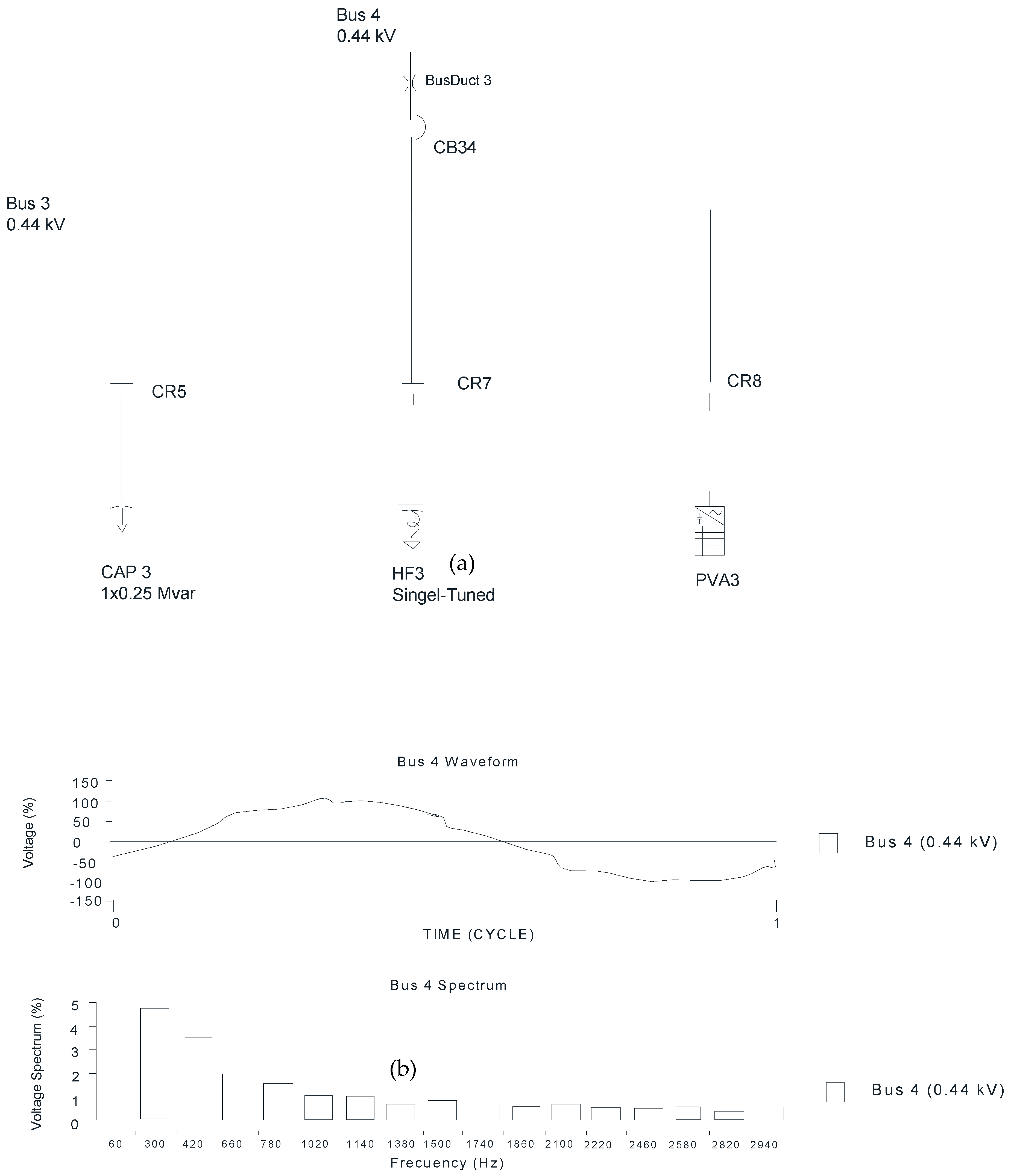
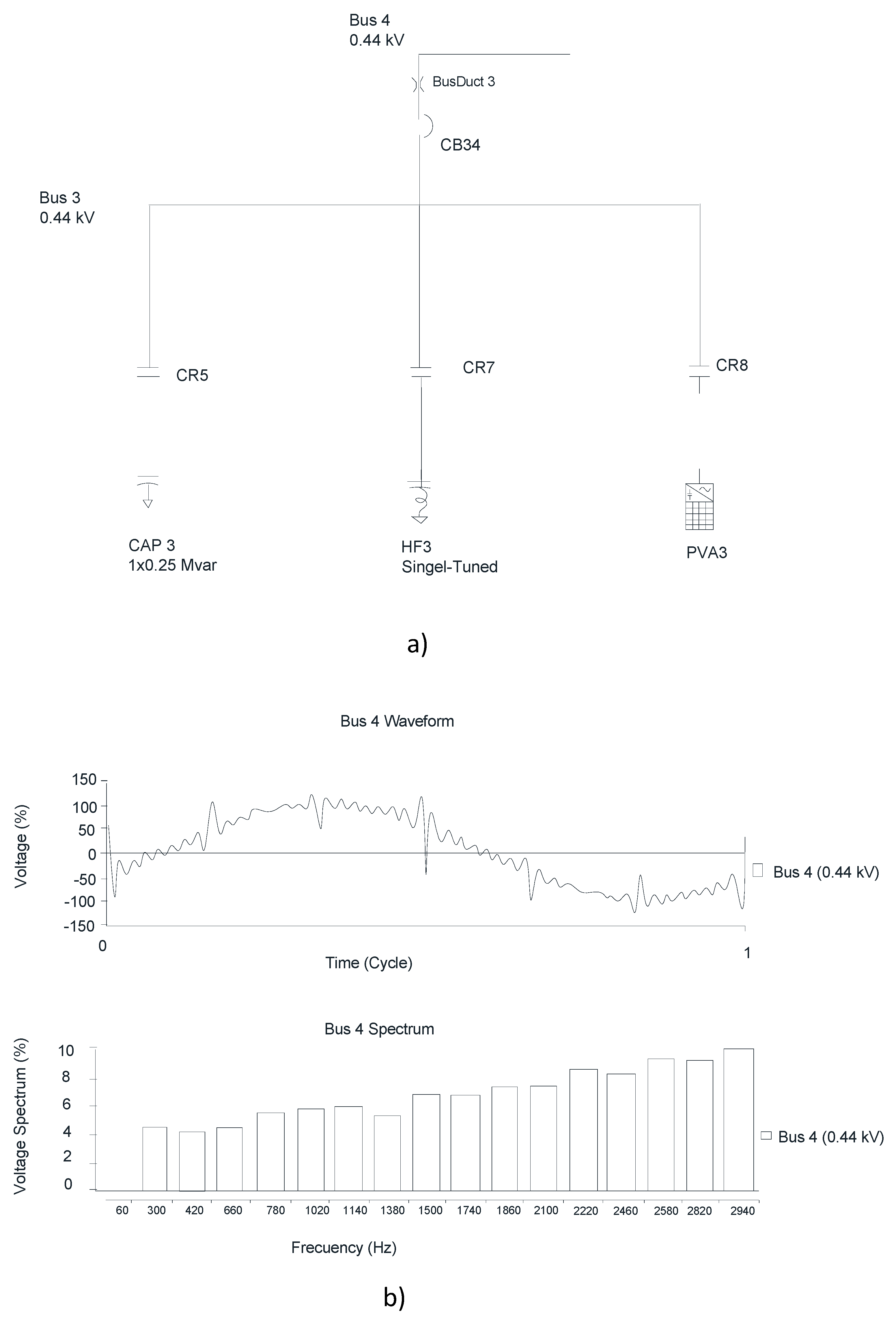
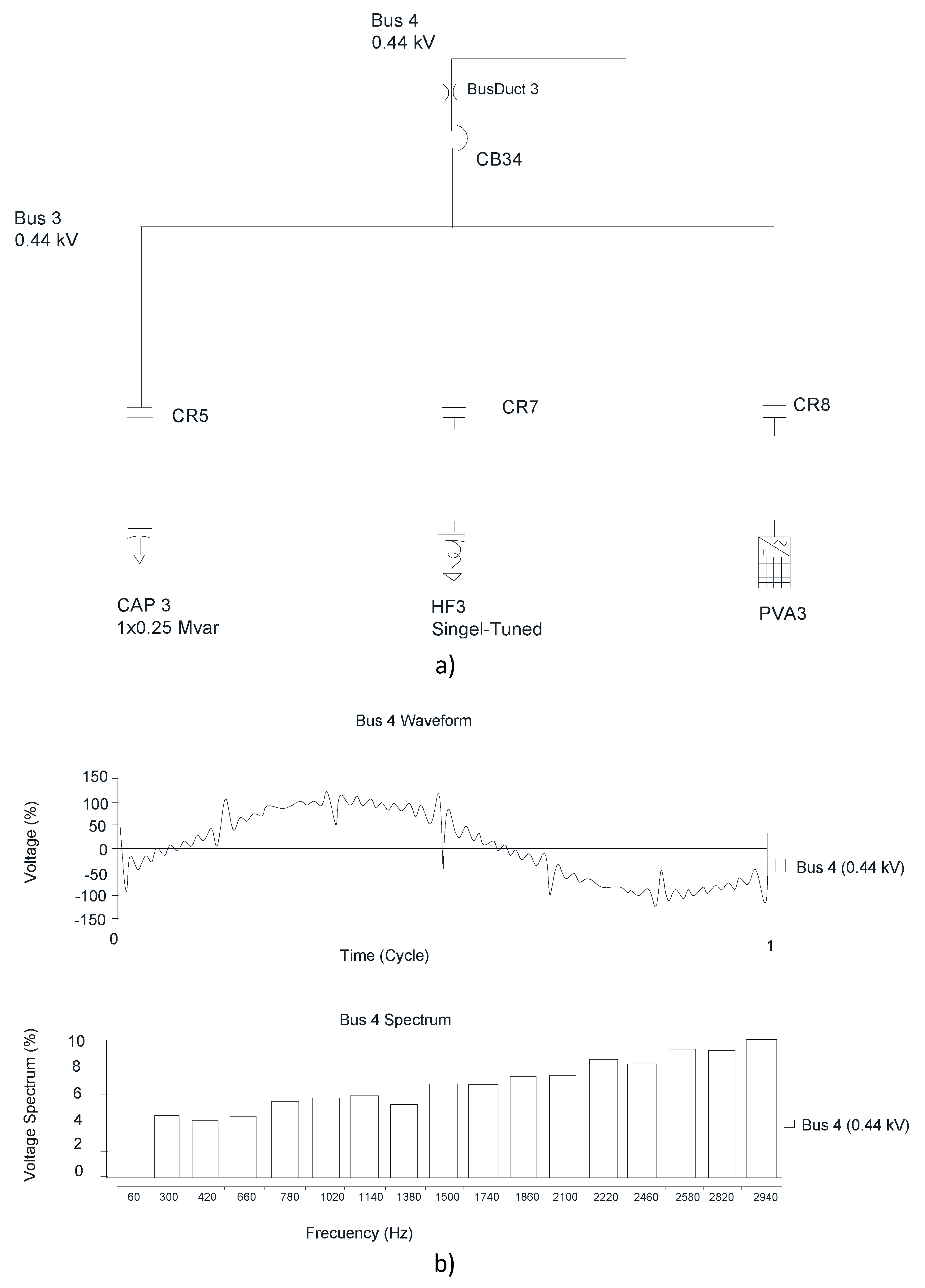
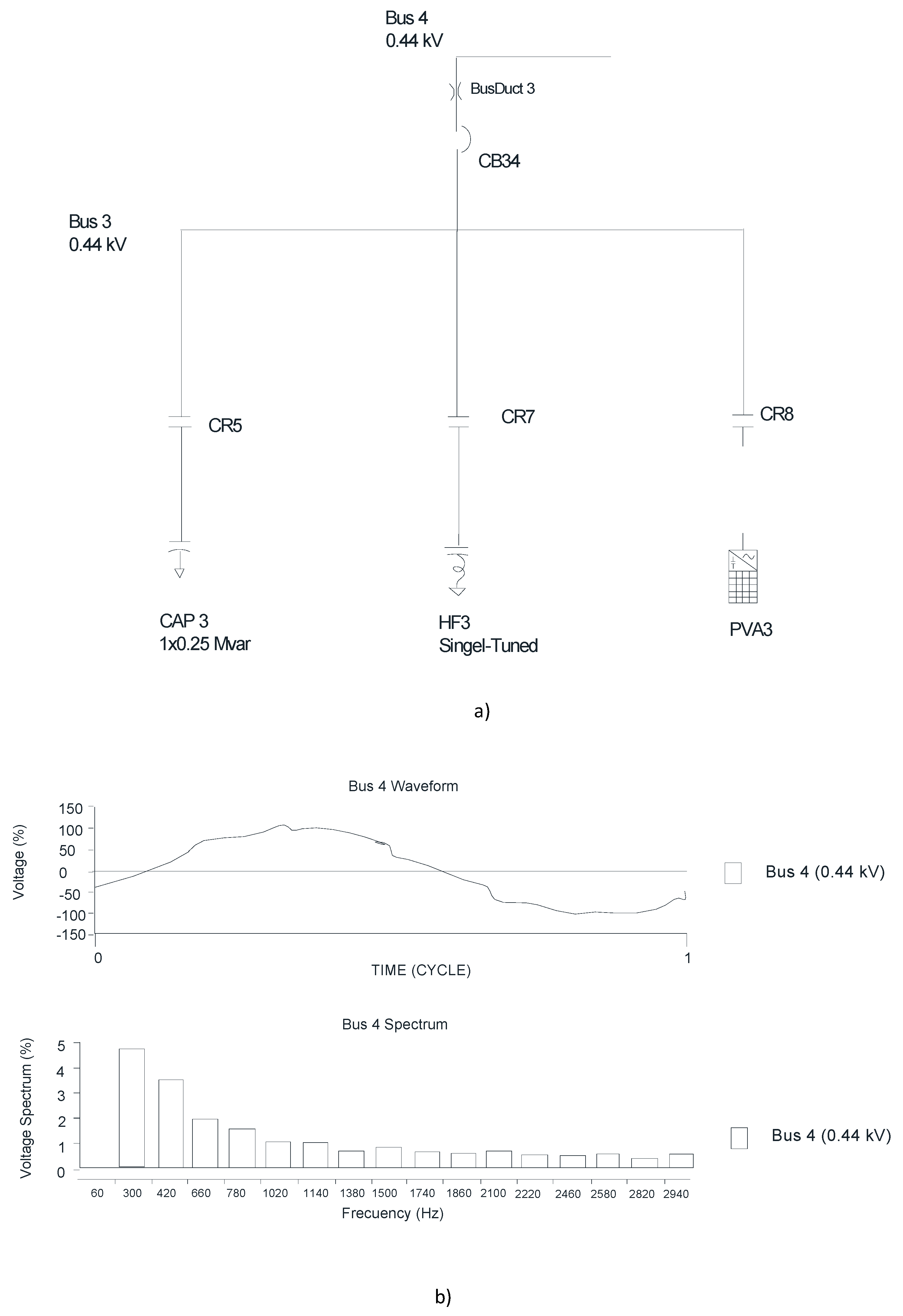
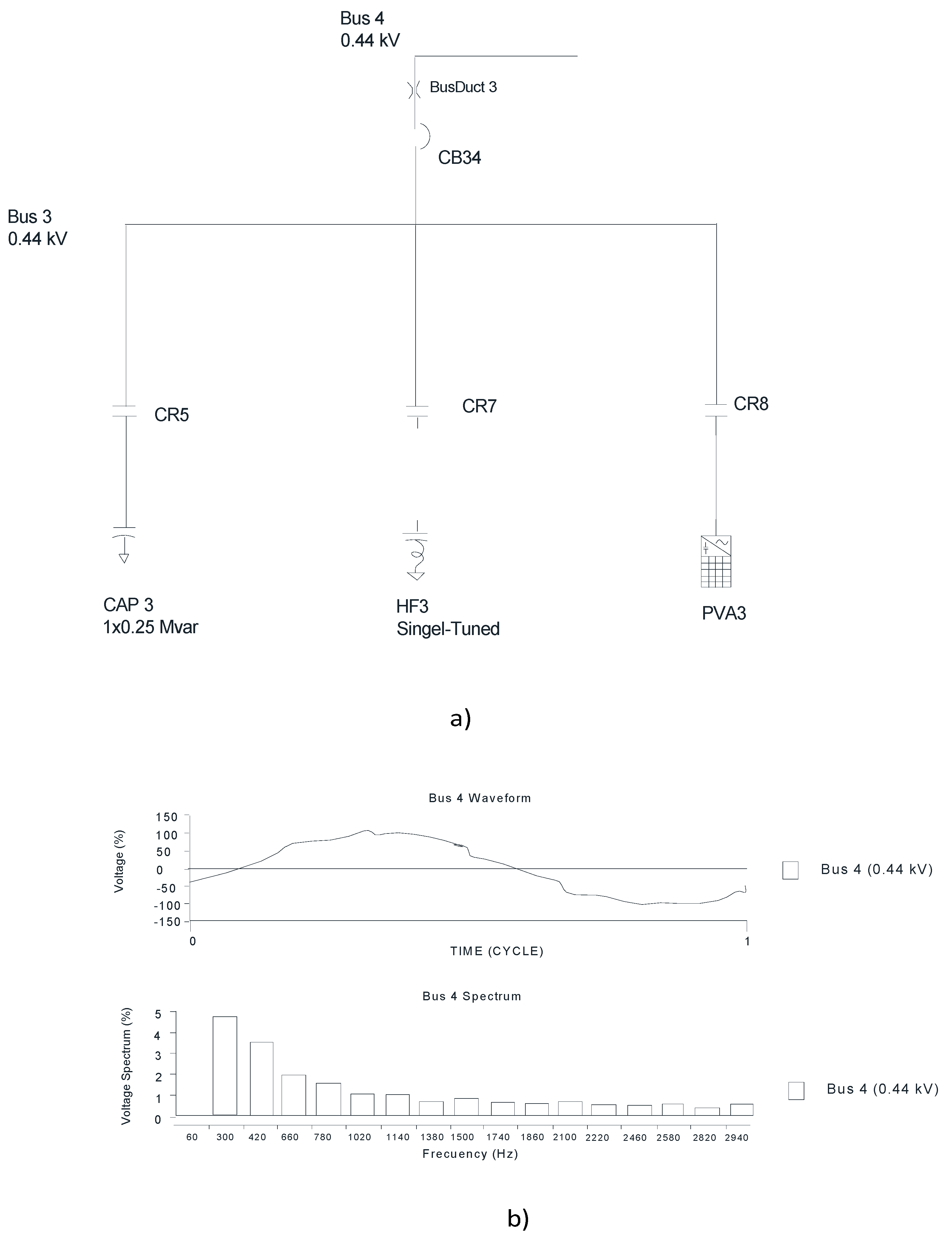
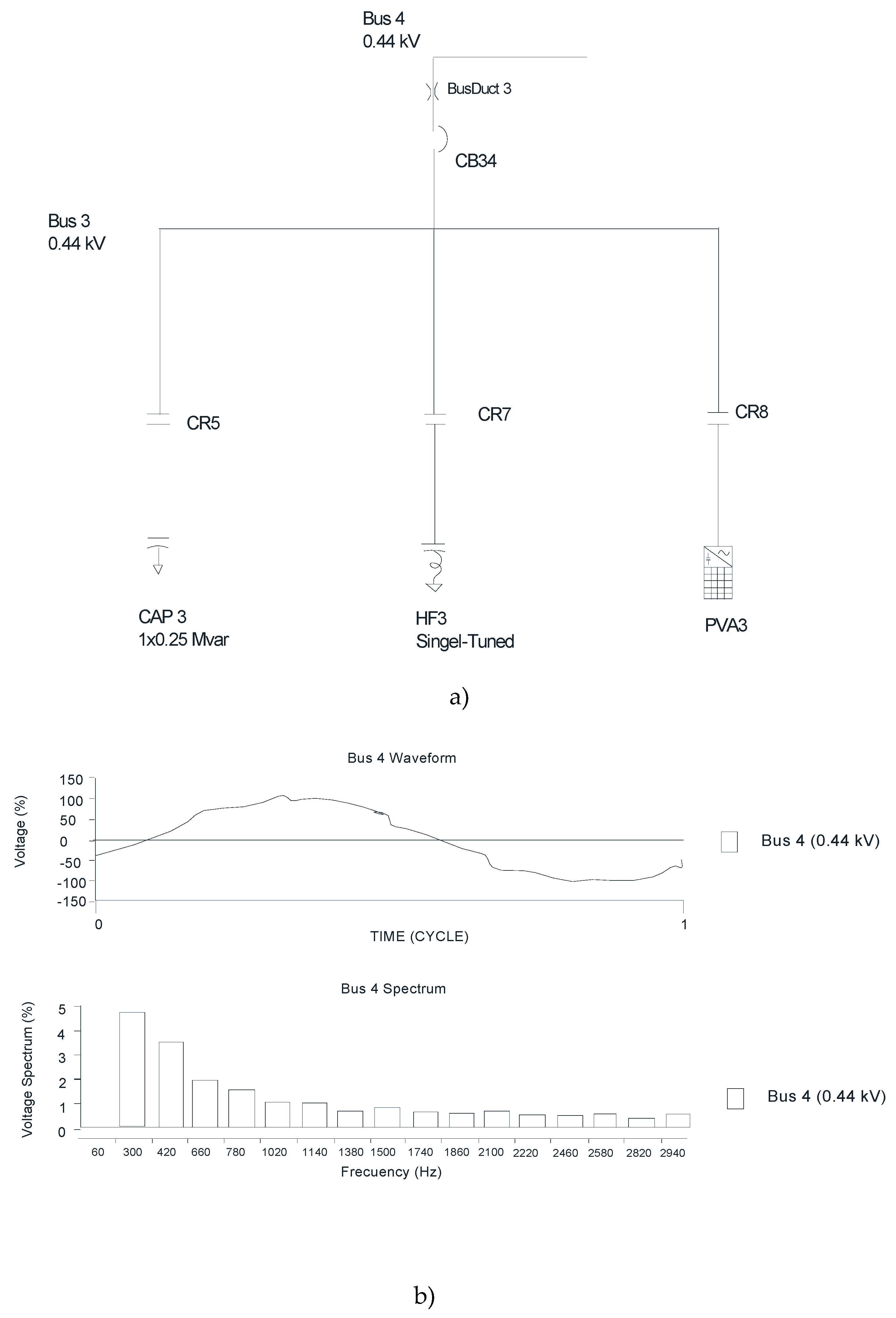
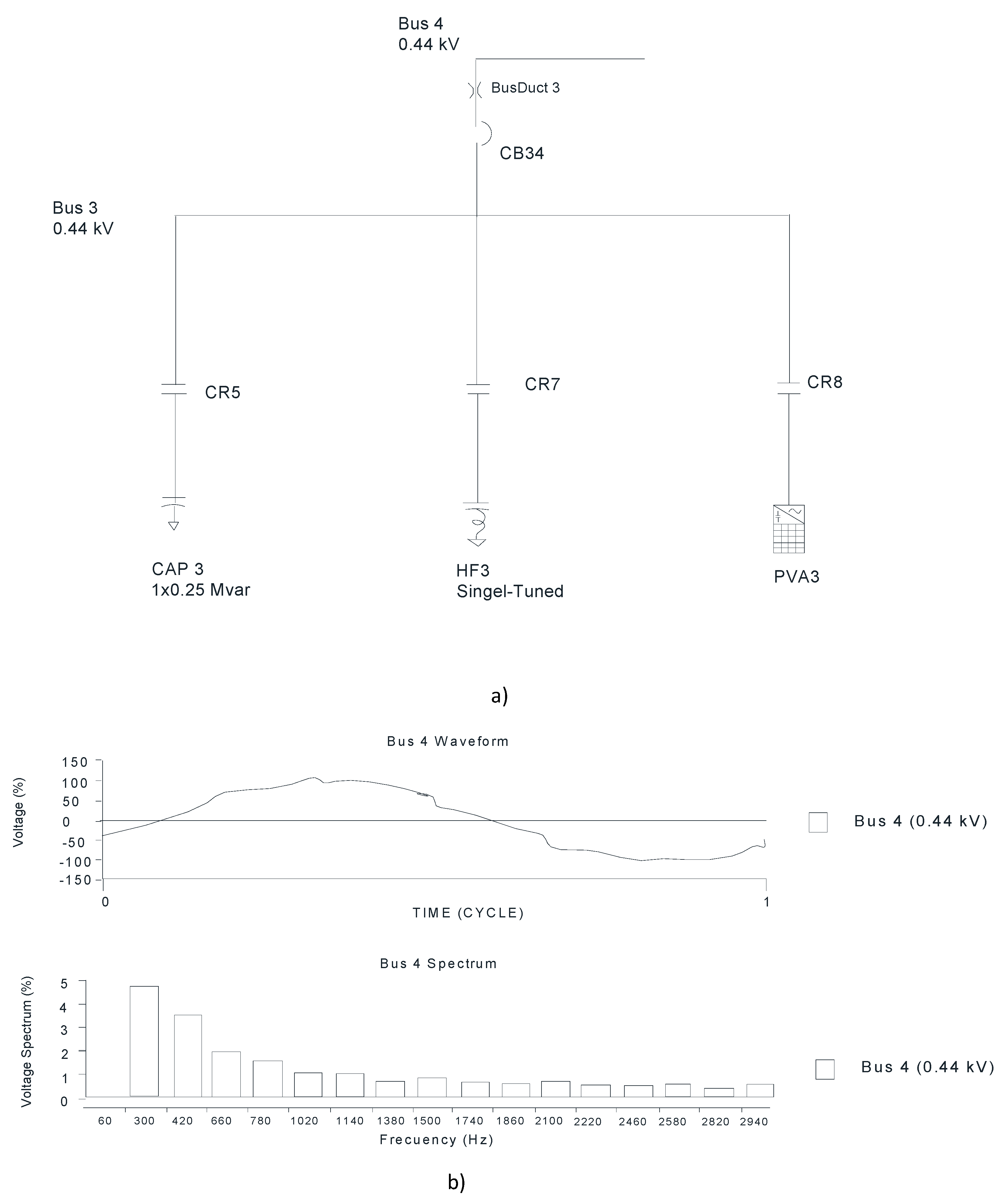
| Analysis of Variance of Current, Using Adjusted SS for Tests | ||||||
|---|---|---|---|---|---|---|
| Source | Degrees of Freedom | Sum of SquareSeg. | Adj.Sum of Square | Adj.Mean Square | F Ratio | p Value |
| Power Active | 2 | 4.00 | 4.00 | 2.00 | 0.16 | 0.853 |
| Power Reactive | 1 | 4.17 | 4.17 | 4.17 | 0.33 | 0.571 |
| Power Aparent | 1 | 6.00 | 6.00 | 6.00 | 0.48 | 0.497 |
| Error | 19 | 237.83 | 237.83 | 12.52 | ||
| Full | 23 | 252.00 | ||||
| Nomenclature | Equipment | Power (W/H.P.) | Control Diagram | ||||||
|---|---|---|---|---|---|---|---|---|---|
| a | b | c | d | e | f | g | |||
| CR5/CAP3 | CR7/HF3 | CR8/PVA3 | CR5-CR7/CAP3-HF3 | CR5-CR8/CAP3-PVA3 | CR7-CR8/HF3-PVA3 | CR5-CR7-CR8/CAP3-HF3-PVA3 | |||
| Mtr1 | Mallacriba 1 | 372.5/0.5 | X | ||||||
| Mtr4 | Mallacriba 2 | 372.5/0.5 | X | ||||||
| Mtr2 | Straightenera 1 | 8940/12 | X | X | |||||
| Mtr3 | Straightening machine 2 | 8940/12 | X | ||||||
| Mtr5 | Bending machine | 7450/10 | X | X | |||||
| Mtr6 | Compressor | 7450/10 | X | X | |||||
| Mtr7 | Heavy Drag | 7450_/10 | X | ||||||
| Mtr8 | Light Drag | 22,350/30 | X | X | X | X | |||
| Mtr9 | Straightening | 2235/3 | X | ||||||
| Mtr10 | Rolling machine | 3725/5 | X | ||||||
| Mtr11 | Slitter | 3725/5 | X | X | |||||
| Mtr12 | Drawing machine 1 | 18,625/25 | X | X | X | X | |||
| Mtr13 | Drawing machine 2 | 14,900/20 | X | X | X | ||||
| Mtr14 | Drawing machine 3 | 11,175/15 | X | X | |||||
| Mtr15 | Drawing machine 4 | 18,625/25 | X | X | X | X | X | ||
| Mtr16 | Drawing machine 5 | 14,900/20 | X | X | X | ||||
| Mtr17 | Drawing machine 6 | 22,350/30 | X | X | X | X | X | ||
| Mtr18 | pump | 3750/5 | X | ||||||
| Mtr19 | Geared motor | 7450/10 | X | ||||||
| Mtr20 | Mallacriba 3 | 2235/3 | X | ||||||
| Mtr21 | Mallacriba 4 | 2235/3 | X | ||||||
| Mtr22 | Mallacriba 5 | 186.5/0.25 | X | ||||||
| Equipment | Current (A) | Power Factor (%) | Waveform Characteristics | |||
|---|---|---|---|---|---|---|
| Transformer T1 High Side | Transformer Low Side (Bus 4) | Transformer T1 High Side | Transformer Low Side (Bus 4) | Transformer T1 High Side | Transformer Low Side (Bus 4) | |
| Capacitor bank (CAP3) | 12.9 | 386.8 | −93.42 | −92.17 | Regular | Good |
| Voltage-current filter (HF3) | 12.6 | 377.9 | 90.06 | 91.1 | Bad | Bad |
| Photovoltaic System Arrangement (PVA3) | 8.4 | 252.4 | 89.94 | 90.63 | Regular | Bad |
| Capacitor bank (CAP3) and Voltage-current filter (HF3) | 12.5 | 374.3 | −76.52 | −74.56 | Regular | Good |
| Capacitor bank (CAP3) and Photovoltaic Array (PVA3) | 11.5 | 344.2 | −77.65 | −75.87 | Regular | Good |
| Photovoltaic system array (PVA3) and Voltage-current filter (HF3) | 8.7 | 259.7 | 94.21 | 94.81 | Bad | Good |
| Photovoltaic system array (PVA3) and Voltage-current filter (HF3) and Capacitor Bank (CAP3) | 12.5 | 373.3 | −76.52 | −74.56 | Regular | Regular |
Disclaimer/Publisher’s Note: The statements, opinions and data contained in all publications are solely those of the individual author(s) and contributor(s) and not of MDPI and/or the editor(s). MDPI and/or the editor(s) disclaim responsibility for any injury to people or property resulting from any ideas, methods, instructions or products referred to in the content. |
© 2023 by the authors. Licensee MDPI, Basel, Switzerland. This article is an open access article distributed under the terms and conditions of the Creative Commons Attribution (CC BY) license (https://creativecommons.org/licenses/by/4.0/).
Share and Cite
Rodríguez, V.A.M.; Villaseñor, N.V.; Solís, J.M.R.; Barbosa, O.A.G. Impact of Automation on Enhancing Energy Quality in Grid-Connected Photovoltaic Systems. Energies 2023, 16, 6161. https://doi.org/10.3390/en16176161
Rodríguez VAM, Villaseñor NV, Solís JMR, Barbosa OAG. Impact of Automation on Enhancing Energy Quality in Grid-Connected Photovoltaic Systems. Energies. 2023; 16(17):6161. https://doi.org/10.3390/en16176161
Chicago/Turabian StyleRodríguez, Virgilio Alfonso Murillo, Noé Villa Villaseñor, José Manuel Robles Solís, and Omar Alejandro Guirette Barbosa. 2023. "Impact of Automation on Enhancing Energy Quality in Grid-Connected Photovoltaic Systems" Energies 16, no. 17: 6161. https://doi.org/10.3390/en16176161
APA StyleRodríguez, V. A. M., Villaseñor, N. V., Solís, J. M. R., & Barbosa, O. A. G. (2023). Impact of Automation on Enhancing Energy Quality in Grid-Connected Photovoltaic Systems. Energies, 16(17), 6161. https://doi.org/10.3390/en16176161






